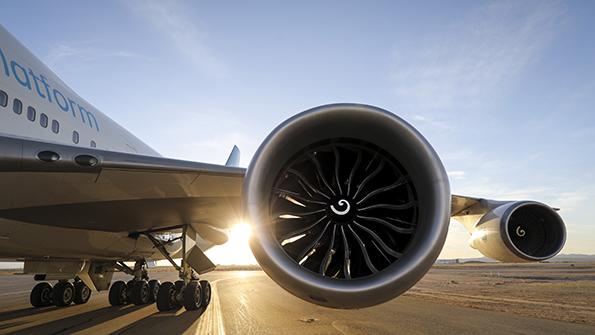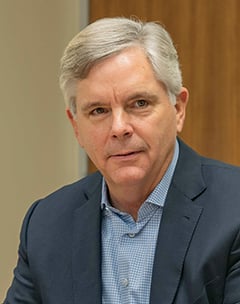
Delays in the Boeing 777X have given GE Aerospace breathing room to work through a combustor problem on the new GE9X high-bypass turbofan.
In November 2021, GE CEO Larry Culp unveiled a plan to split the 129-year-old industrial conglomerate into three companies and spin off all but its aviation business by early 2024. Last June, he took on a dual role as CEO of GE Aerospace, nudging aside John Slattery.
Culp sat for an interview with Aviation Week Editor-in-Chief Joe Anselmo and Senior Propulsion Editor Guy Norris at GE Aerospace’s headquarters in Evendale, Ohio.
- 70% of GE Aerospace revenues will be aftermarket
- RISE is an umbrella for multiple technology bets
- CEO hints at investments in hypersonics

AW&ST: You’re in the middle of transforming GE from an industrial conglomerate into a pure-play aerospace company. What inning are you in? I love baseball, so I like the way you framed the question. We’re probably in the middle innings. The process we laid out in 2021 is more than halfway along, with GE HealthCare having been spun out in January. We’re in a position to do the same with GE Vernova in early 2024, leaving GE Aerospace as the stand-alone business that we aspire to be.
When you get to the finish line, Aerospace is going to be 70% maintenance, repair and overhaul, which looks great in today’s market. Are you comfortable with that percentage of aftermarket in the business over the long term? A lot of people don’t appreciate the reality that 70% of the business is in the aftermarket. It’s those decades-long relationships with customers in the aftermarket that define what we do and the economics of the business. I’m not a big believer in trying to shape those sorts of ratios. We are who we are, and that is the business model that has been built up over time.
Airbus has expressed some concern about the future of Rolls-Royce as a viable supplier to their widebody line. Do you think that could be an opening for GE to get back into Airbus on the widebody side? We have active dialogs with Airbus and Boeing on their product road maps and how we might fit in and influence what they would do with the widebodies and narrowbodies. I’m going to refrain from getting into details, but you should assume that those are active, ongoing discussions.
Everybody is in wait-and-see mode on new product launches, particularly in the widebody market. We really like where we are on the Boeing 787—over 60% underwing—-and we’re excited about the 777X. The widebody market is in a much better place than it was just a few years ago. We’re on the cusp of no longer talking about where we are vis-a-vis 2019 departure levels. I suspect as we go through the back half of this year, and certainly into 2024, we’ll be free of that unfortunate history and just talk about this business growing. Our view is that this industry is poised to grow, even with some of the macro pressures that are weighing on other sectors.
On the narrowbody side, Airbus is considering launching a larger A220, the A220-500. If it did move forward with such a project, would GE have any interest in participating in it? Again, we are in active discussions with all the major airframers, but I’m not going to comment specifically about one rumored platform versus another.
We tried. You did on both, admirably.
One more. Comac’s C919 is entering service in China using a CFM International Leap turbofan. Is the C919 a one-and-done for you, or is it possible we could see a GE engine on a future Comac aircraft? We’re in the early stages with the C919, working with our friends at Comac. We’ll work with them on what happens from there, but I wouldn’t want to comment in any detail.
We’ve heard positive news on the results of the investigations into the recent combustor problem on the GE9X high-bypass turbofan developed for the Boeing 777X family. Do you think the delays in that airframe put you in a good position by giving you more preparatory time? I think both GE Aerospace and Boeing are making very good use of the time that we have ahead of EIS [entry into service]. We’re thrilled with the progress that we’ve made with the 9X, recognizing that it’s far better for an issue like the combustor liner to surface late in 2022, as opposed to much, much closer to EIS. One of the hallmarks of this engineering organization is making sure that we’ve got a robust design review and testing regime, so those sorts of issues are surfacing and resolved as early as possible. That episode, in our view, was one of the highlights of the program, though it wasn’t necessarily characterized by some in that way.
As you look ahead to the GE-Safran RISE program, there are many options out there. Where do you think it will go in terms of first application? Do you imagine it really will be an open fan when it enters service in the 2030s? You just touched on the reason why we wanted to frame this as a technology development, as opposed to a product development. We know we sit at the center of a solution to the sustainability challenge, not for any one platform but for the industry. The renditions that you’ve had in your publication with an open-fan architecture underwing represent the future, but the future we will see in the next decade. We’re not yet talking about products per se, but there will be more details in Paris. We’re excited about that perhaps being the first product manifestation of the RISE investments.
That technology suite underpins a lot of potential that could be spun off into the existing family—future spirals of Leap, for example. Is that something you’re also keeping in your back pocket? We have a very full back pocket. But again, RISE is not a product but an umbrella for a number of technology bets that we have made as we think about what we want to bring to market over the next 10-20 years.
The U.S. Air Force has proposed canceling its adaptive engine development program in fiscal 2024. What is GE’s long-term future in military combat engine work if you don’t make a breakthrough at some point with your XA100 adaptive engine program? We don’t view our combat position as dependent on one decision, but the XA100 is important. There’s a reason Congress has spent $4 billion [since 2007] to develop that technology. We’re in dialog with folks on Capitol Hill on what their investment has yielded thus far and what the engine can do in-theater relative to mission requirements. We’re optimistic that the program will continue, and there are other efforts around NGAD [the Air Force’s Next-Generation Air Dominance fighter] that are also of interest. You can rest assured that the combat market is of significant strategic importance to GE Aerospace.
Where are you in GE’s Lean manufacturing overhaul, and is it actually saving you money? It’s early innings, but I’m really encouraged. Our mantra is safety, quality, delivery—before cost—but I believe that we are saving money. I see the waste that’s coming out of the system. I think the primary benefit we’re getting today is delivery. It’s a daily battle within our own four walls and with our suppliers and their suppliers to ramp up, given everything that many industries are dealing with post-pandemic. I don’t think we would be shipping as many Leap engines if we were not executing this Lean transformation. In time, it’s going to help us with productivity as well, but that’s not the primary orientation today.
GE won a significant victory with the U.S. Army’s Improved Turbine Engine Program, but there are delays in shipping out test engines. Where are you now? I think we’ll get those engines out this year. I don’t want to make excuses, but these supply chain issues have been acute, particularly for new platforms. This is widespread—large companies, small companies, Tier 1, Tier 2, Tier 3. Everyone is dealing with the same root causes. In the U.S., we drew down a lot of capacity during the pandemic. The commercial industry almost went to zero, and we were uncertain when it might come back. It’s come back with a vengeance, thank goodness, but the experienced folks in our shops didn’t necessarily come back. So there’s a good bit of restaffing and retooling going on.
How is GE facing the challenge of meeting the aviation industry’s goal of achieving net-zero emissions by 2050? Our biggest advantage is that we’ve been at this for decades. We didn’t call it sustainability; we called it efficiency. But what is required technically and operationally is by and large the same. Given the investment envelope we have with RISE and other capabilities, in terms of both design and manufacturing, we’re positioned to play a meaningful leadership role.
Do you think we’ll see a hydrogen-powered GE engine? I wouldn’t rule anything out. The real question is when. This is a company that has been innovating back to Thomas Edison, and there’s no reason we’re going to stop now.
There are at least four contracts in the public record that GE has won for hypersonics work. Do you see the company becoming a force in that area? Any propulsion-based opportunity, commercial or military, is going to be of interest to us. Our approach is to let actions speak louder than words, which means you’ll see us invest and do the hard work ahead of any big headlines or announcements. On hypersonics, I’ll just leave it there. For now.
You became CEO of GE Aerospace a year ago. What are your plans for when the unwinding of GE is complete? Do you see yourself staying on? The last year has been an absolute blast. The people, technology, strategy, commercial issues, policy—this industry has everything. So when we launch GE Aerospace, you’ll see my role change simply in that I will go from having two titles to one. And Aerospace will be the one that prevails. Maybe it’s in my blood—you be the judge. But it’s a really neat spot.

